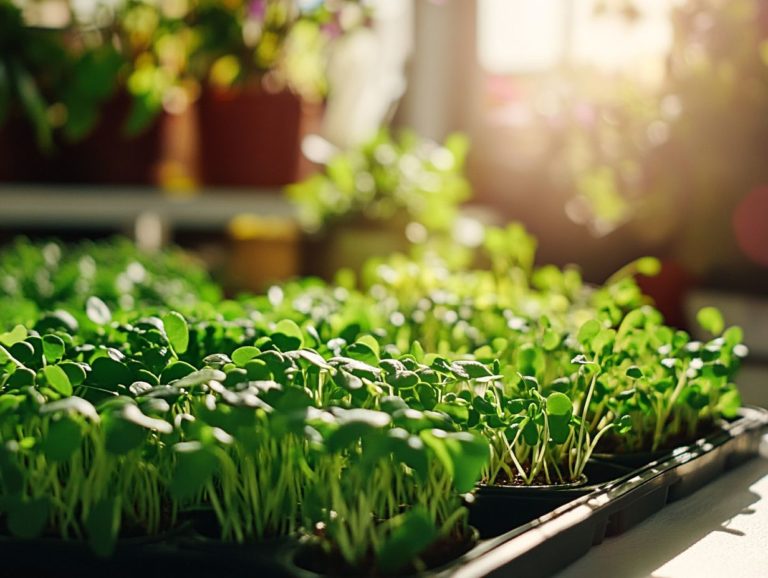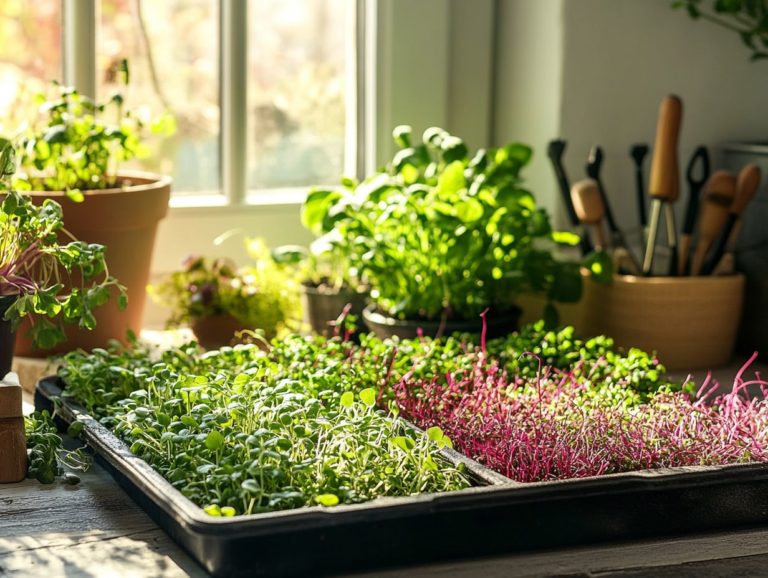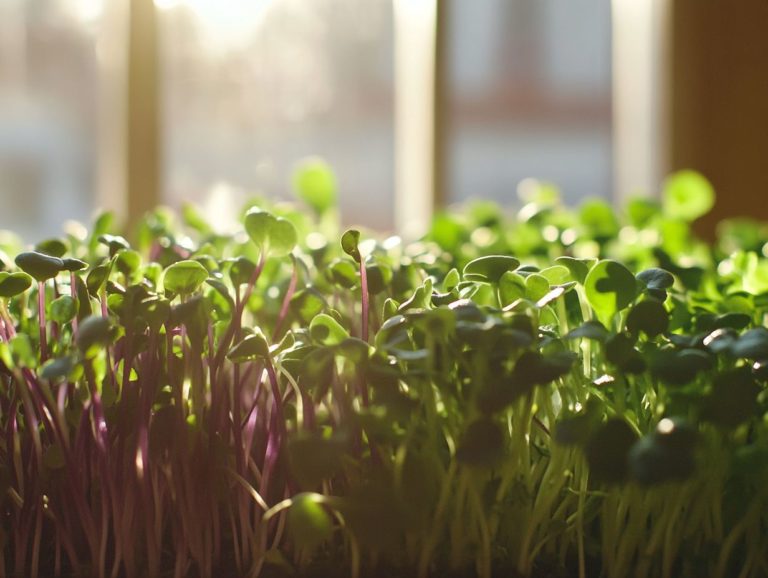Watering Techniques for Thriving Microgreens
Microgreens are small, nutrient-dense plants that deliver remarkable flavor and health benefits, making them a fantastic choice for home gardening.
To successfully cultivate these delicate greens, proper watering techniques are crucial.
This guide will walk you through the essentials of watering microgreens, highlighting the importance of hydration and the various factors, including water quality, that influence their needs.
You ll uncover effective watering techniques, identify common pitfalls to avoid, and gain troubleshooting insights to ensure your microgreens flourish, preventing mold and other issues.
Master the art of keeping your greens vibrant and healthy with these essential care tips!
Contents
- Key Takeaways:
- Essentials for Watering Your Microgreens
- Unlock the Best Watering Techniques for Thriving Microgreens
- Common Mistakes to Avoid
- Troubleshooting Watering Issues
- Frequently Asked Questions
- What are the best watering techniques for thriving microgreens?
- How often should I water my microgreens?
- Can I use tap water to water my microgreens?
- Should I water my microgreens from the top or bottom?
- What are some signs of overwatering my microgreens?
- Can I use a watering can to water my microgreens?
Key Takeaways:
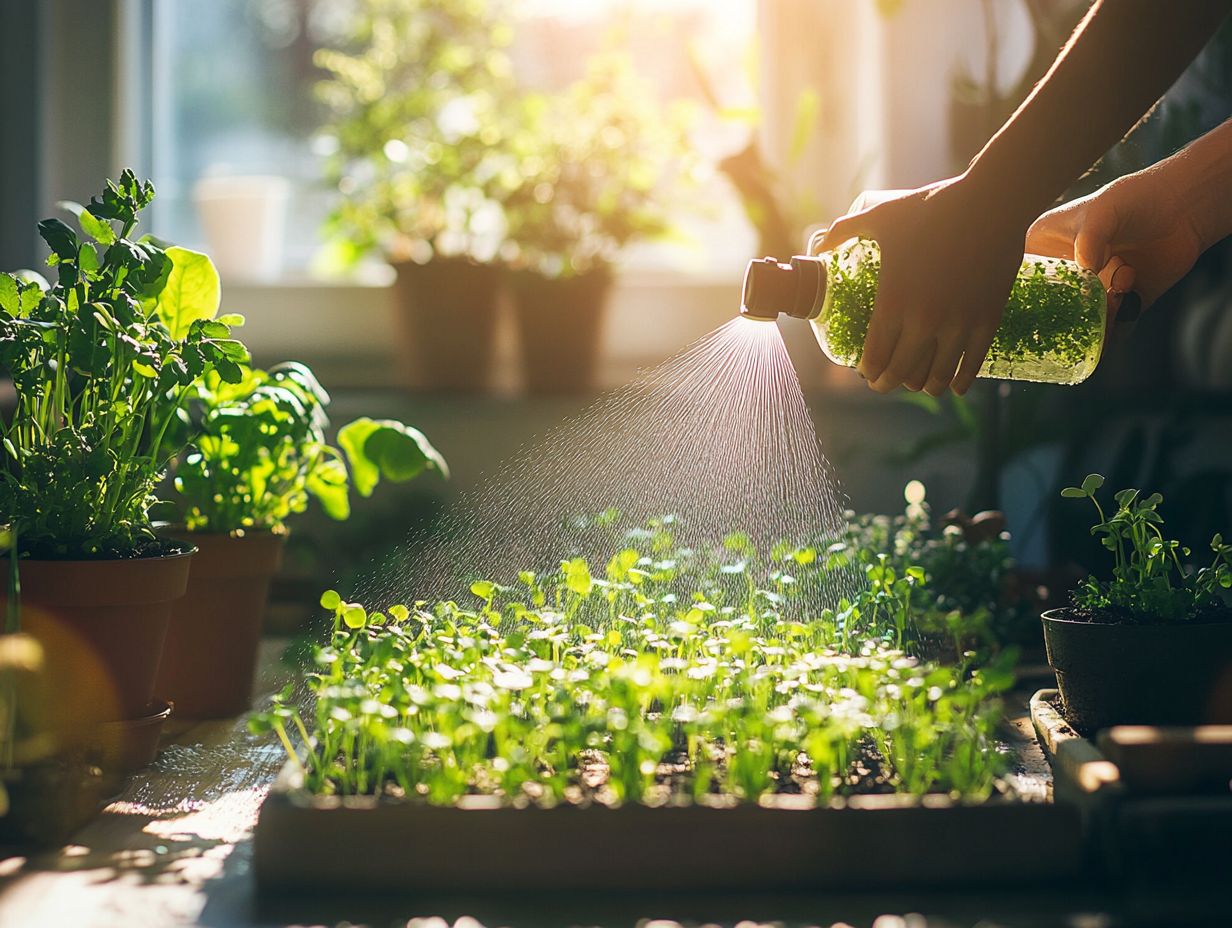
- Proper watering is crucial for the growth and success of microgreens, as it directly impacts their roots and overall health.
- Factors such as soil moisture, water quality, and humidity levels should be considered for optimal watering.
- Avoid over or under watering by using techniques such as bottom watering, misting, or drip irrigation, and regularly checking soil moisture levels to ensure the best conditions for growth.
What are Microgreens?
Microgreens are young, edible plants that you can harvest shortly after germination, typically within 7 to 21 days, making them an excellent choice for quick gardening. They come in a delightful array of microgreen varieties, like cilantro and Brussels sprouts, each offering unique nutritional benefits.
These young greens burst with flavor and are a concentrated source of vitamins, minerals, and antioxidants that support a healthy diet. They make a fantastic addition to your meals.
You can grow microgreens in soil, such as peat moss or coco coir, or through hydroponics, giving you plenty of options for how to cultivate them.
Their vibrant colors and intense flavors can elevate a wide range of dishes, from fresh salads to elegant garnishes on sophisticated meals, showcasing the benefits of home-grown microgreens. Whether you prefer to nurture them indoors on a sunny windowsill or dedicate a garden space to their growth, understanding the environment is key.
Microgreens can adapt to various conditions that fit your lifestyle. Effective care involves maintaining the right moisture levels and ensuring they receive adequate light whether from fluorescent bulbs or natural sunlight to support their germination and growth.
When it s time to harvest, you can simply snip the delicate greens with scissors, making it easy to incorporate them into your culinary creations. Embracing these tiny powerhouses opens the door to a world of flavor and nutrition right in your own home.
Essentials for Watering Your Microgreens
Grasping the essentials of watering microgreens is pivotal for their thriving growth, as water is a key player in both germination and the overall health of the plants, which affects how they grow.
With proper watering techniques, you can maintain the ideal moisture levels in the soil, allowing the seeds to sprout and establish robust roots. This careful approach also helps you steer clear of potential pitfalls, such as overwatering or under watering, which can invite mold and a host of other issues.
Why Watering Matters for Microgreens
Proper watering is essential for your successful cultivation of microgreens, as it directly impacts their growth stage, roots, and overall health. Maintaining adequate moisture levels supports healthy root development and helps prevent mold, a common issue that arises from excess water due to poor drainage.
Understanding the environmental factors influencing watering such as humidity, temperature, and air circulation is crucial for developing robust microgreens.
By implementing effective care techniques, such as misting or bottom watering, you can promote uniform hydration while minimizing the risk of over-saturation. Use techniques like misting or bottom watering to keep the soil evenly moist. This helps avoid over-saturation and supports your plants healthy growth.
Paying close attention to the growth stage of your microgreens allows for tailored watering routines and methods, ensuring they receive just the right amount of moisture. Master these techniques to boost your harvest and grow vibrant, nutrient-packed microgreens that will impress you!
Ready to get started? Grab your seeds and start your microgreen adventure today!
Factors to Consider
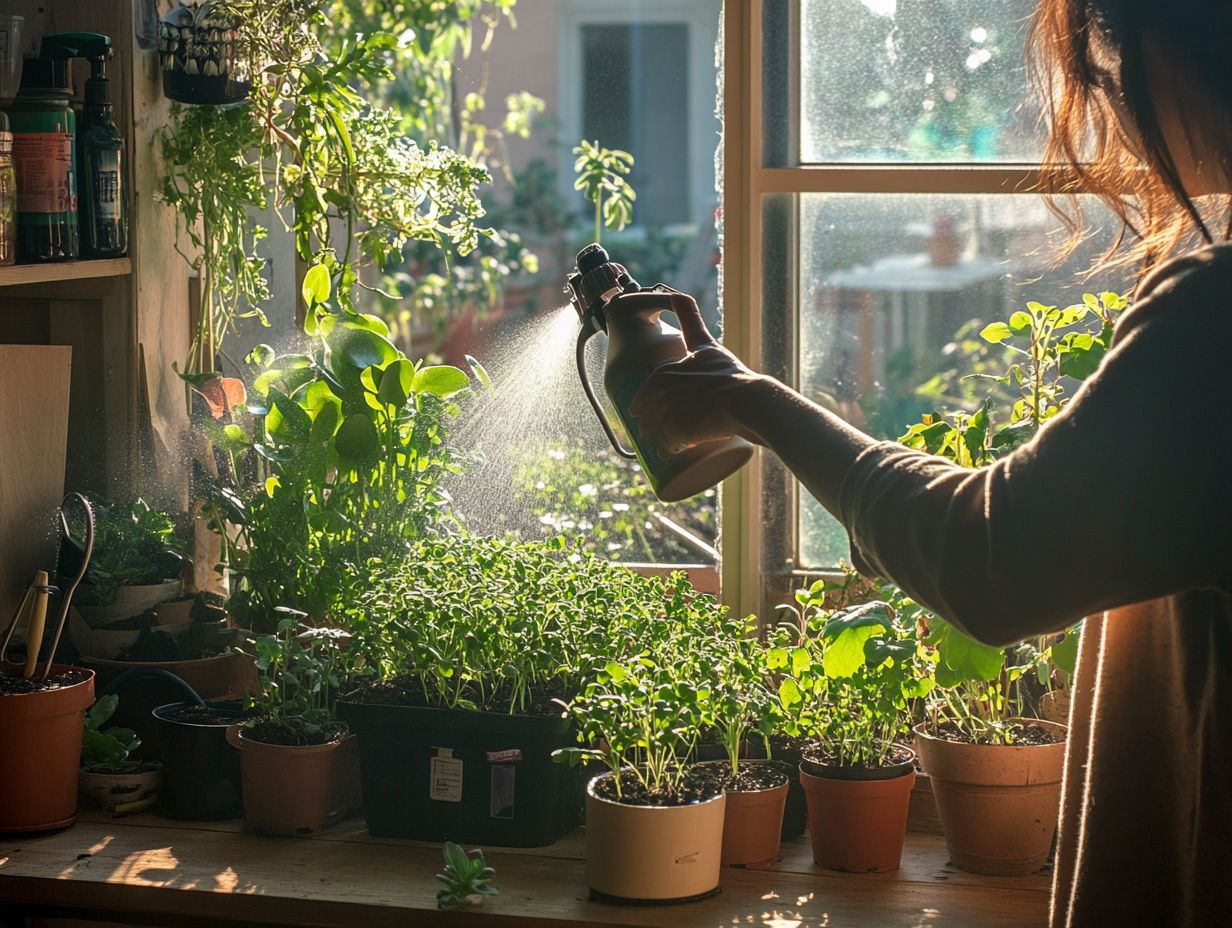
When watering microgreens, consider several important factors for optimal growth. These include humidity levels, soil composition, pH balance, light exposure, and nutrient availability.
Each element plays a crucial role in how well your microgreens absorb water and thrive. High humidity can slow evaporation rates, reducing the frequency of watering.
Conversely, drier air requires more frequent moisture checks to avoid plant stress. The composition of your soil, especially its moisture retention, impacts accessibility to water.
Don’t overlook pH balance, as it affects nutrient availability and uptake. Light exposure is crucial because it helps plants make their food.
Understanding these elements helps you manage nutrients and improves plant health, setting you up for a bountiful microgreens harvest.
Unlock the Best Watering Techniques for Thriving Microgreens
Identifying optimal watering techniques can significantly elevate growth and help you avoid common pitfalls like under or overwatering.
Methods like pump sprayers and a well-designed drainage system are crucial for maintaining ideal moisture levels.
Top Methods for Watering Microgreens
Several effective methods cater to diverse growing conditions, whether using soil trays or hydroponics. Bottom watering, misting, and pump sprayers can ensure adequate moisture without overwatering.
Bottom watering fills trays with water, allowing plants to absorb moisture from the roots. Misting gently hydrates foliage and works well for smaller setups. For larger gardens, a pump sprayer provides precise control.
Moisture meters help monitor hydration levels effectively. Each method has unique advantages, so consider your specific environment and microgreens’ needs.
Common Mistakes to Avoid
Avoiding common mistakes is essential for successful cultivation and preventing mold. Both overwatering and underwatering can lead to stunted growth and nutrient deficiencies.
Be mindful of moisture levels and apply proactive care tips to enhance the health of your microgreens.
How to Prevent Over or Under Watering
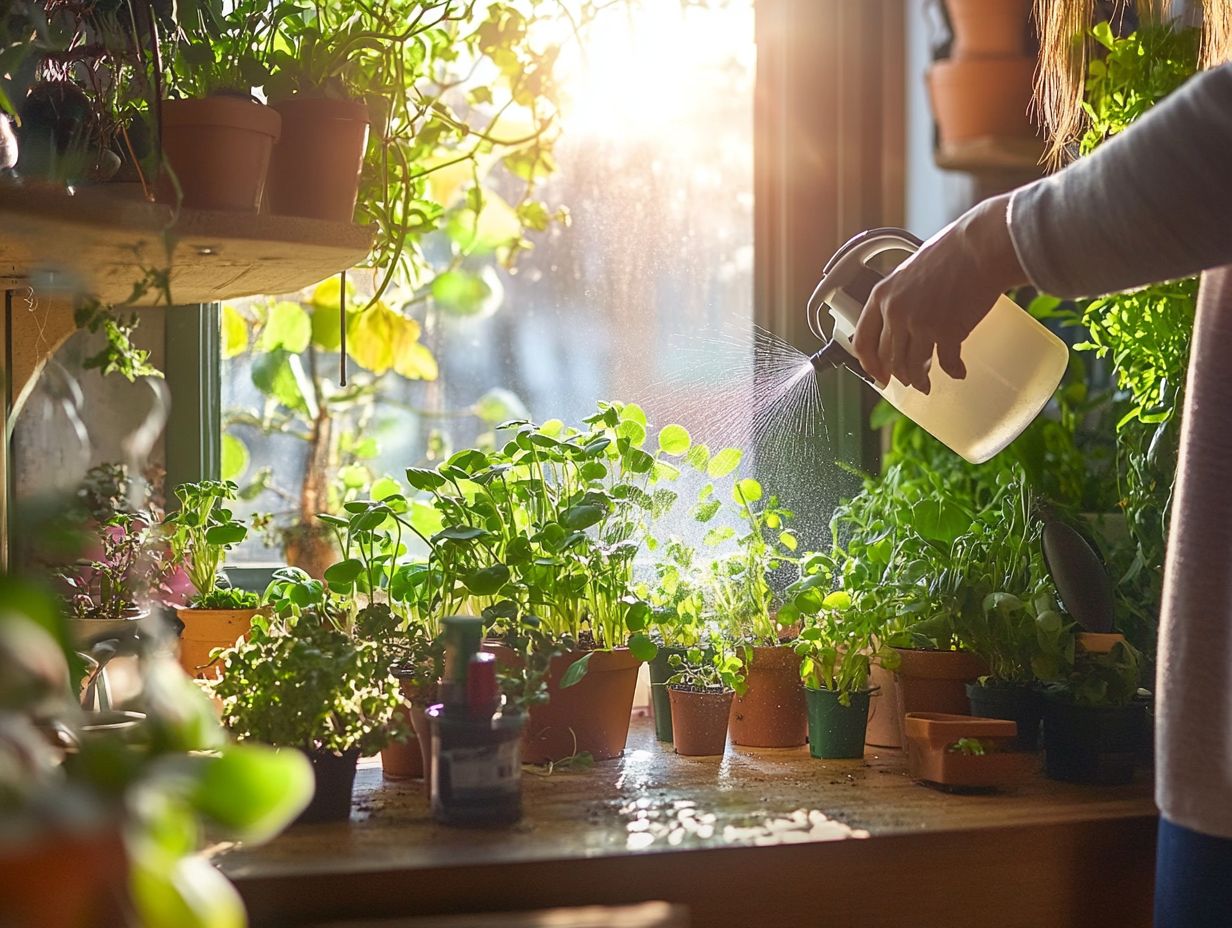
Preventing both overwatering and underwatering is crucial for the health of your microgreens. There are several techniques at your disposal, including devices that measure moisture in the soil, to strike that perfect moisture balance. Monitor environmental conditions. Adjust your watering schedules and use moisture meters to enhance hydration.
Carefully observing the humidity and temperature of your growing space allows you to make informed decisions about when to introduce water. This is vital for your microgreens’ success. Establishing a routine of frequent checks provides essential insights and cultivates a habit of attentiveness one that can save entire crops from the dangers of improper watering and ensure you achieve the best yield.
Incorporating techniques like bottom watering ensures even absorption and minimizes surface runoff. Keeping those drainage holes clear is also vital for preventing waterlogged conditions, which can lead to root rot. Ultimately, achieving consistency in moisture management is the cornerstone of thriving microgreens and essential for home cultivation.
Troubleshooting Watering Issues
Troubleshooting watering issues is essential for the successful growth of your microgreens, as it impacts their overall health. Identifying and addressing watering issues early can protect your crop from potential damage and improve your cultivation practices.
One common challenge is inconsistent moisture levels. You can often resolve this by employing effective watering techniques and fine-tuning your growing conditions, especially with humidity control.
Identifying and Addressing Problems
Identifying and addressing watering problems swiftly is crucial for the health of your microgreens. Signs like yellowing leaves or stunted growth often point to issues related to moisture, indicating a lack of proper care. By recognizing these indicators, you can effectively adjust your care strategies to restore optimal growing conditions and ensure your microgreens thrive.
To maintain a flourishing microgreen garden, closely monitor moisture levels and understand the specific needs of each plant variety, including cilantro and Brussels sprouts. Overwatering can suffocate roots and encourage mold growth, while underwatering may lead to wilting and nutrient deficiencies, significantly impacting your microgreens’ yield. Make it a habit to check the soil moisture daily; your microgreens will thrive with your attention!
If you notice excessive dampness, adjust your watering schedule immediately to prevent mold. On the flip side, if the soil dries out faster than you expect, increase the frequency or volume of water you provide to support healthy growth. Making these adjustments will ensure a thriving environment for your microgreens and contribute to their overall success, so be sure to follow the best practices for microgreen growth.
Frequently Asked Questions
What are the best watering techniques for thriving microgreens?
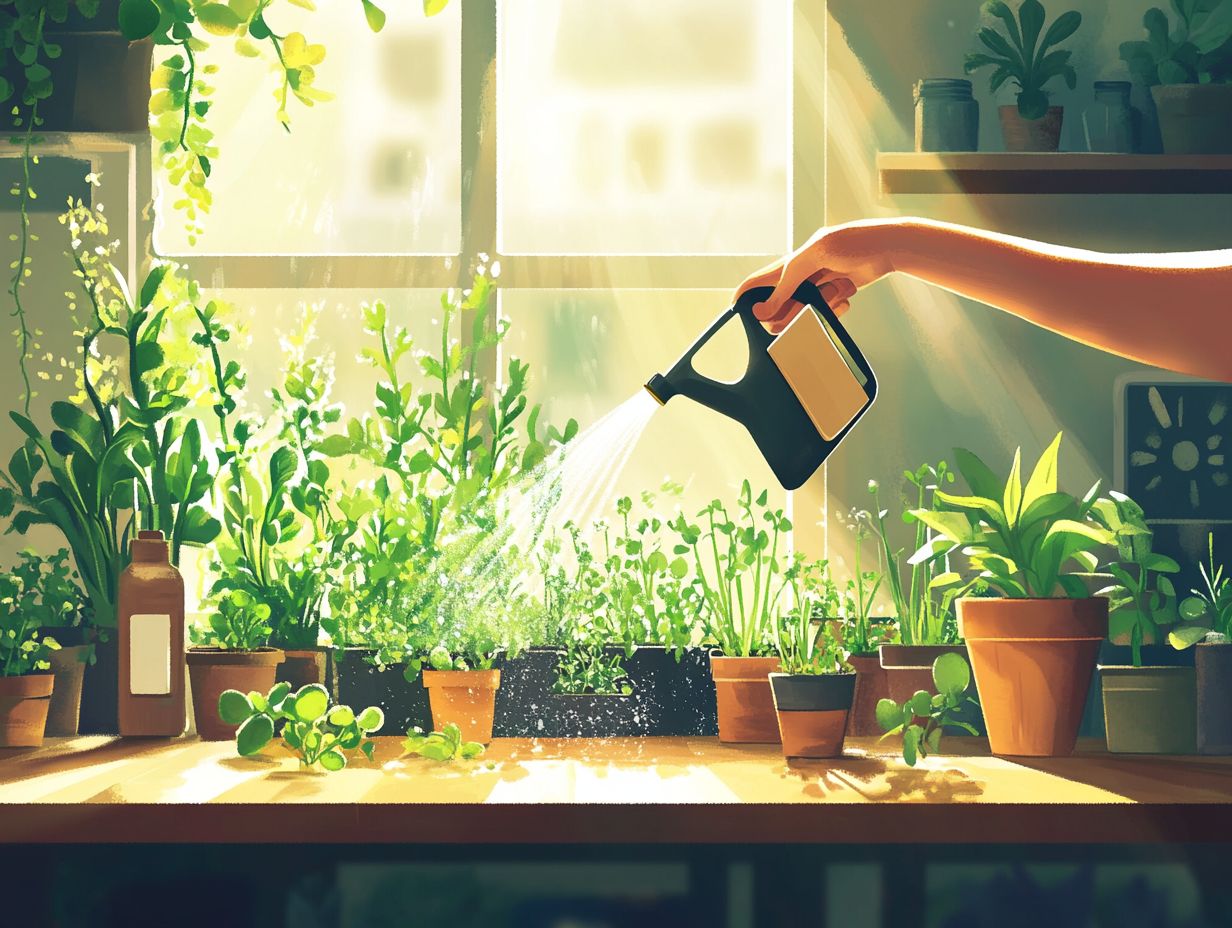
The best watering technique for thriving microgreens is to use a spray bottle or mister to lightly water the surface of the soil. This mimics gentle rainfall and prevents overwatering, which can lead to mold growth or root rot.
How often should I water my microgreens?
Microgreens need to be watered once or twice a day. This depends on the humidity and temperature of your growing environment. Keep the soil consistently moist, but not waterlogged. Make it a habit to check the soil moisture daily and adjust your watering schedule accordingly.
Can I use tap water to water my microgreens?
Use filtered or distilled water for the best results. Tap water may contain chlorine or other chemicals that can harm the delicate roots of microgreens. If you must use tap water, let it sit for 24 hours to allow the chlorine to dissipate.
Proper watering techniques are essential for the success of your microgreens. With the right care, your microgreens will flourish.
Should I water my microgreens from the top or bottom?
It is best to water microgreens from the bottom. This method keeps your delicate leaves safe and sound while helping prevent mold on the soil surface.
What are some signs of overwatering my microgreens?
If your microgreens are yellowing or wilting, overwatering might be the issue. Look out for mold or fungus on the soil’s surface as well.
Adjust your watering schedule and ensure the soil drains well to avoid these problems.
Can I use a watering can to water my microgreens?
Using a watering can is tricky. It can lead to overwatering if not handled carefully.
If you must use one, choose a fine nozzle and water at the base of the plants, not on the leaves. Keep your greens thriving by watering wisely!



